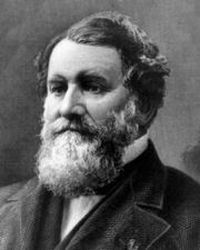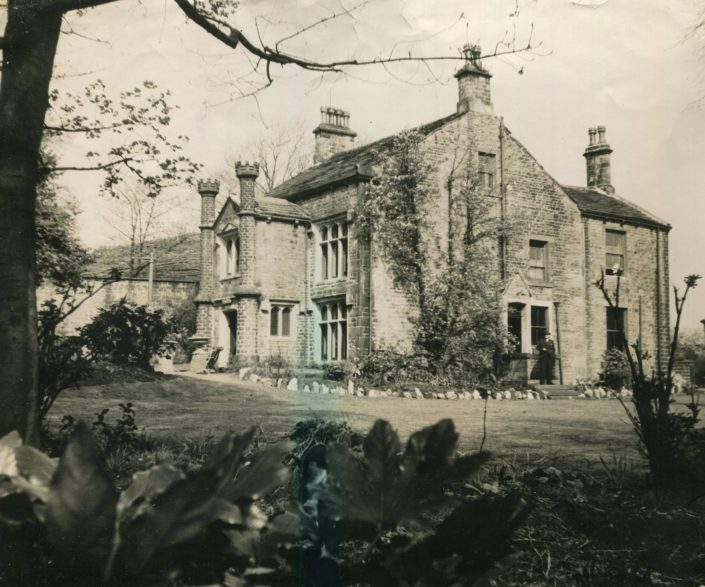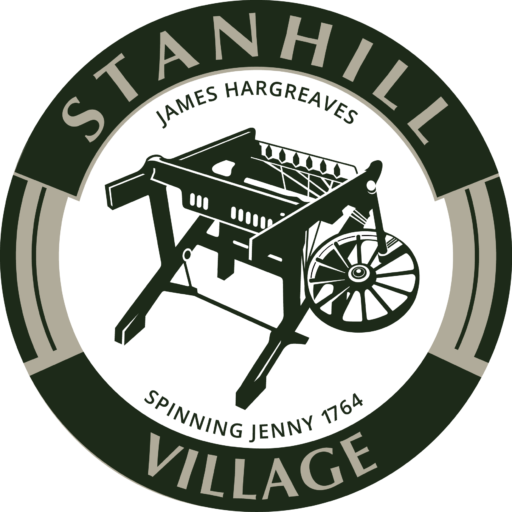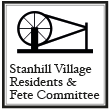Stanhill Village is probably best known as the former home of James Hargreaves and the site of his revolutionary invention – the Spinning Jenny.
 For many centuries, wool and flax (used to make linen) had been changed from fibers (the raw material) to thread, or yarn, using a spinning wheel. The wheel was turned by hand or, in some cases, by using a foot peddle. The motion of the wheel turned a spindle which pulled on the fibers. This caused the fibers to be drawn out and twisted to make yarn.
For many centuries, wool and flax (used to make linen) had been changed from fibers (the raw material) to thread, or yarn, using a spinning wheel. The wheel was turned by hand or, in some cases, by using a foot peddle. The motion of the wheel turned a spindle which pulled on the fibers. This caused the fibers to be drawn out and twisted to make yarn.
James Hargreaves [ c1720 -1778] was a weaver who lived in Stanhill Village, near Blackburn in Lancashire. He was poor, uneducated and had a large family. It is said that, in 1767, one of his daughters accidentally knocked over his spinning wheel. As Hargreaves watched the overturned machine, he noticed that the spindle continued to spin, even though it had now been turned over by the fall. It occurred to him that the same wheel might be used to turn many spindles at the same time. He set about making a machine with eight spindles connected to one wheel. He called his machine the Spinning Jenny. (Jenny was a general name used for machinery at the time – it was not the name of any of Hargreaves’ daughters!)
Hargreaves made a number of Spinning Jennies and started to sell them in the area. However, since each machine was capable of doing the work of eight people, other spinners were angry about the competition. In 1768, a group of spinners broke into Hargreaves’ house and destroyed his machines. Hargreaves decided to move his family away from Blackburn and they settled in Nottingham. Here Hargreaves found a partner, Thomas James, and together they set up a small spinning mill.
Although he patented his invention in July 1770, Hargreaves had already given away its secrets during the six years since its conception. The Spinning Jenny had already been duplicated by others. Hargreaves never earned very much in the way of royalties and continued to work in his spinning mill until his death in 1778. Nevertheless his estate at the time of his death was £4000, a decent sum at that time.
The popular view is that Hargreaves lived in the cottage which was until recent times the village post office.
A History of Stanhill Hall
[once the home of William Westall, the Novelist]
 An extract from ‘Old Homesteads of Accrington and District’ by Richard Ainsworth, published 1928.
An extract from ‘Old Homesteads of Accrington and District’ by Richard Ainsworth, published 1928.
Standing upon the hill above Oswaldtwistle, Stanhill is an interesting old village. It has an old-world aspect, although modern developments encroach upon it – on the West End side the fine modern spinning mill and in the Brookside direction Vine Factory: memorials of that inventive genius James Hargreaves, whose spinning jenny did so much toward the industrial revolution which made Lancashire what it is.
A time-honoured Lancashire custom, celebrated every year on the first Sunday in May, is the Charity Sermons at Stanhill, really the Sunday School Anniversary, known far and wide as Stanhill Fair. The school children parade the village in their best attire, sing in front of Stanhill Hall and at various points in the village, accompanied by a string band – surely reminiscent of days when the ‘cello, flute and violin were the accompaniment of old-time Psalm and sacred song. If the day be bright and fine, crowds gather at Stanhill on this prominent day.
Besides the old-world charm of its homesteads and inns, and the schools comprising the village, there is a fine old house known to the villagers as the Manor House, in reality Stanhill Hall: truly a pleasing picture of an old English village, and more so before industrialism crept within its borders.
Stanhill Hall, a beautiful old home, standing well back from the road with a carriage way to the house, forms a pleasing picture with its two-storey porch and double turrets, and high-pitched roof. The extensive grounds are surrounded by a high, strongly-built stone wall, while formerly and entrance and carriage way through the grounds was by of the new Blackburn road.
The hall is not ancient, for it does not date beyond 1748. But we must remember it was the 18th century, a period to all intents and purposes dead to all architectural interest in the way of beauty of ornamentisation or detail of building, at least in most parts of the country. And Stanhill Hall is the one redeeming feature of our district of 18th century architecture. For the most part others then erected were devoid of any pretensions to beauty or art. This lack of ornamentation was also carried out in the erection of their churches, which were more like barns than places of worship.
The road which passes through Stanhill must have existed for centuries, and was the old road to Blackburn for Oswaldtwistle, Church, and Accrington people long before the modern Blackburn road was thought of.
Stanhill is said by tradition to have received its name from Stand Hill, from which watchers kept a look-out for marauders from over the border. Others say it derives its name from Stone Hill.
Near by the old road, almost on the site of the present hall, stood an older mansion. When, or by whom, it was built does not appear to be known, but apparently the Rishtons of Ponthalgh had Stanhill Hall for a residence. Ponthalgh can very clearly be seen from the rear of Stanhill Hall, and would not be a great distance away when approached by the old lane by the side of the hose leading by Aspen to Church Kirk. It suffered in all the vissicitudes of the family of that house – uncompromisingly Romanists – in 1630. Ralph Rishton of Stanhill and his family, compounded for their estates by the annual payment of £5. Moreover, Ralph Rishton, the elder, of Stanhill Hall, and Ralph Rishton, the younger, of White Ash, evidently father and son, had their estates of Stanhill and White Ash sequestered for recusancy.
Recusancy signified the refusal of the person accused to comply with the requirements of the Ecclesiastical laws of the country. Roman Catholics who attended Mass in private houses by priests of their own Church were recusants. Obstinate recusants were sent to gaol and their goods sequestered, or the rents collected from their farms and estates by the King’s officers until the offenders professed repentance or were reduced to submission.
During the turmoil of the Civil War the Rishton were Royalists, and by 1652 the adherents of the King felt the full force of being on the losing side. None suffered more than Ralph Rishton, the elder, of Stanhill Hall, for his estates were confiscated and sold by order of Parliament in 1652. No man could suffer more save with his life than he – turned out of his ancestral home a pauper to wander where he could. Let us hope he found an asylum with the younger Ralph at White Ash, who compounded for his estates by the payment of £57 10s.
Who occupied Stanhill Hall immediately after the Rishtons it is difficult to determine, but near the close of the century it was possessed by the Haworth family. A branch of this family, of considerable standing, was the Haworths of Woolhurst Bank, Accrington. Various branches of the family held land in Accrinton, Haslingden, and Green Haworth. Stanhill Hall became the possession of John and Jonathan Haworth. Few particulars of this member of the family are to be gathered beyond the fact of his being married and that he had a son and daughter, George and Dorothy, the successive owners of Stanhill.
George Haworth never married, and when he succeeded to his heritage determined to pull down the old home, described as a substantial farm house, and re-build it as a mansion. He must have been a man of considerable taste and interested in art and architecture to have built such a beautiful house at that period.
After his death the hall and estates passed into possession of his sister, Dorothy, then of Green Haworth, she married William Halstead of Moor (September 13th 1761). With this marriage began the branch of the Halsteads of Stanhill Hall, thirteen years after the present hall was erected. The had four children-three sons and one daughter, none of whom married: William (of whom there is not the slightest trace, save that his brother Henry said he died unmarried): John, baptized November 6th 1763; Henry, baptized January 6th 1766; and Mary, baptized May 15th 1768.
The Halsteads were generous benefactors. John’s name appears on the list of contributors to St. James’s National School, Accrington. Their names are to be found in the contributions toward the erection and endowment of Christ Church, Accrington. Henry Halstead was the last member of the family. By his will he bequeathed £2,000 to endow Emmanuel Church, Oswaldtwistle. He also left £4,000 to endow other churches in the parish of Whalley, of which £1,000 was left to endow another church, when required, in Oswaldtwistle. That sum, with accumulations, was paid to St. Paul’s Church, Oswaldtwistle, some years ago.
These legacies were left in 1840. Elijah Nutter, and George Pickup, of Accrington, were the executors under Henry Halstead’s will, which was drawn up by John Townend, Holcombe Hill, near Bury. Their being no heir to succeed to the hall, it came into possession of lawyer Brandwood, who took the name of Halstead. He did not enjoy it for long, for he committed suicide.
Stanhill Hall and estates afterwards passed into the hands of the Westalls, of White Ash. They were then “running” the old White Ash factory.
Chief interest in the Westall possession of Stanhill lies in the fact that it was the home of William Westall, the novelist. Here he commenced his literary career, and his story of the “Old Factory” will ever be of interest in the neighbourhood. The “Old Factory” was the White Ash Mill run by his father, and many of the characters in the book were drawn from among the people he remembered in his early days. “Adam Blackthorn,” a typical Lancashire character in the early days of the cotton industry, and Moorwells Manor House, thinly disguise his home – Stanhill Hall. Here young Westall wrote a great portion of his book. He made generous use of the house, the family, and their acquaintances, and the district around. “Redburn” disguises Blackburn, while Haslingden is not disguised at all.
The story is laid in the days when power-looms were displacing hand-looms, when people were driven to desperation at the prospect of losing their living. In the story, the plan to attack the Old Factory is overheard at a roadside inn, and when the rioters came to smash the looms they are defeated in their purpose. Two old pipes were camouflaged to look like guns, while some of the workmen wore military uniform. Firing of blank shot and the lavish use of hose pipes pouring streams of water upon the rioters completed their discomfiture.
William Westall died September 12th 1903 aged 69 years. He had been resident in Switzerland many years previous to his death, and from there wrote a good many novels.
William Metcalf afterwards became the owner and occupier of Stanhill Hall. He entered the coal tar industry in the days when possibilities of its development were almost undreamt of; an industry which is a romance in itself. William Metcalf took an interest in public affairs, and for several years was Chairman of Oswaldtwistle Local Board. A very unassuming and generous-hearted man, he found pleasure in helping others. What more can be said of any man? He died May 18th 1902, aged 77.
The hall was purchased from the executors of William Metcalf and occupied by Mr. Thomas Bradley. The grounds are beautifully laid out. The two-storey porch, with its two battlemented turrets, give the house a striking appearance. In the gable end of the porch are the initials of George Haworth, the builder of the house – “G.H.,” and the date “1748.” Over the porch doorway the initials and date are repeated on raised stone. There is a two-light window over the porch, while on the ground floor and upper floor are two windows of three lights. The porch has a string course over the door, while the windows are label-headed. The old glass has been replaced by windows of Gothic design.
Adjacent to the house are interesting relics of the “Spread Eagle.” These are three iron figures of a spread eagle, which once did duty as a sign. The front entrance still retains the original handsome door with scroll ironwork, and is nail-studded. Inside is an old iron bar to fasten the door. This would stand some battering if an intruder attempted to enter in the days when law and order were more disregarded, without adequate means of enforcing it. The entrance passage has a wide, circular-headed recess in the wall on the left, for the hall stand. One each side of the passage are two fine old rooms-to the left the dining-room, to the right the drawing-room. The latter retains two original wall cabinets, with fine mahogany framed glass doors, which fit the recesses in the wall, one on each side of the mantelpiece. These two rooms are well lighted by French windows.
One can picture, in imagination, these old rooms occupied by the Haworths and Halsteads of the 18th century, with their picturesque dress of brocaded waistcoats, full bottomed coats, knee breaches, silk stockings, and buckled shoes; with their wigs and perukes and their snuff-boxes in general use, and the ladies’ dresses with their full wide skirts. One wonders whether the Society fashions of those days penetrated to these quiet homes of a country squire’s household, where everything seemed tasteful, but not elaborate, bespeaking simple homely virtues rather than scenes, which have been depicted to us, of debauchery and carousals in some of the homes of that period, when to get drunk was the hall-mark of a gentleman.
The most prominent feature of the house’ at the end of the hall passage, is a staircase of 18th century date, one of the finest in the district. It is a substantial piece of work, and in as good condition as when first placed there.
There is recess on the first landing containing a fine statue of Flora, the goddess of flowers – an addition of the early 19th century. A well light in the ceiling gives light to the staircase.
The morning-room is to the left when facing the staircase. On one side of the room is another wide circular-headed recess, similar to the one in the hall passage. It is remarkable for its bookcase and writing bureau. This is evidently a fixture in the recess and is a fine old piece of furniture. It contains secret drawers, which would be of service to the Squires of Stanhill in olden times to hide their wills and valuable papers.
More interesting still is to picture the young novelist, William Westall, sitting in this room and using the bureau on which to pen “The Old Factory” novel, so intimately connected with the house and neighbourhood. He is the one outstanding novelist our district has produced. Long may this house of Stanhill be preserved! Here he planned and dreamed, and worked out those stories that brought him literary fame. A house that has, apart from its historic lore, a literary interest, acquires a human touch and attraction, brought about by the contact of author with his readers, depicting, as they do, the passions and emotions of human life. It is a shrine which witnessed the first literary aspirations of the future novelist.
In the passage leading to the side entrance hangs a fine piece of wood-carving, a panel purchased from the Read Hall sale some years ago.
The old farm buildings are massively built, with great oak rafters supporting the roofs. These date back a few centuries, to the time of the older Stanhill House in the days of the Rishtons. Some of the oak beams have been cut and found to be almost as sound as on the day when they were built into the walls and roof.
In addition to “The Old Factory,” William Westall wrote, among others, the following novels: “Red Rivingto,” “Old Bank,” “Don or Devil,” “As a Man Sows,” “As Luck Would Have It,” “Dr.Wynne’s Revenge,” “Her Ladyship’s Secret,” “Phantom City,” “Queer Race,” “Ralph Norbreak’s Trust,” “With the Red Eagle,” “Red Bridal,” “Sons of Belia,” “Strange Crimes,” “Trust Money,” “Two Pinches of Snuff,” “Woman Tempted Him.”
A STORY OF STANHILL VILLAGE
By Brian Smith
Early Days
Stanhill Village stands high up on the outskirts of Oswaldtwistle. It offers among other things a fine view of all the surrounding towns to those who take time to use the many footpaths in the area.
There are a lot of stories about Stanhill and this is just one of them.
I was born in 1937 in a little cottage [ No 6 I think] on the main road that runs through the village. The cottage stood in front of the mill owned by Messrs W Riley, a weaving concern established in the 19th century.
It wasn’t long before my family moved to a better property at 24Aspen Lane [down t’ Troy]. Our house consisted of four rooms with a lounge that had a cast iron fireplace. The fireplace had little compartments where you could put clothes overnight so that they would be warm in the morning. There were no carpets, just lino and later, some coconut matting in the dining room.
The kitchen housed a mangle and gas cooker but there was no hot water supply. Stone steps led up to the main bedroom which had a small fire grate. This was seldom lit, even in the depths of winter! Some time later we had a gas geyser fitted in the kitchen over the slop-stone. This seemed like a miracle as it provided hot water straight from the tap!
I attended West End Primary School from the age of three years. This was good as it enabled my mother to return to the factory to weave on four looms. This allowed us to have a few more luxuries such as a new wireless and to repair the roof which constantly allowed the rain in. As the nearest pupil to the school it only took me two minutes from leaving our backyard to arriving at the playground.
The winters in those days were a lot more likely to be snowy ones and in February 1947 we experienced the hardest snowfall in anyone’s memory. The snow always seemed powdery and used to blow off the surrounding fields. It would pile up against the stone walls of the lanes. The snow drifted badly on this occasion and completely blocked Aspen Lane from top to bottom. I still got to school though! I walked down from our back door on top of the wall that ran from the last house to the school. I was the only pupil to get there that morning together with two teachers.
In those days Aspen Lane was an ‘unfinished’ surface lane with a footpath down the side next to the Hall. The top part of the lane was full of potholes that made travelling up an down it a pretty rough journey. However, there were very few, if any, motorised vehicles around.
Over The Counter
Stanhill at this time was pretty much self-sufficient. We had a very good selection of shops. These included the post-office, the Co-op, a confectionary shop, and a chip shop and a haberdashery.
The Post Office
This was run by Mrs Taylor and it sold stamps, postal orders and stationery. It had a little counter where she sold sweets when they were available – which was very rare indeed! She also sold and delivered newspapers.
The Co-op
This was the main store in the village and was located opposite the Hall at the end of ‘Co-op Row’ as it was called. The manager was brilliant as he used to sell broken biscuits to us kids even if he had to break some in the first place! When you walked into the shop the aroma from the ground coffee beans would be the first thing you noticed. The shop was the main supplier of groceries for most of the village residents. I remember going to get our shopping after school and not having to pay anything as the manager would let you have goods ‘on tick’, to be paid for at the end of the week on pay-day. Every customer had a Co-op number so that they could get a ‘divvy’ on ‘Divvy Day’ which was a partial refund based on how much you had spent over a certain period. Our number was 199 and I have never forgotten it.
Mrs Anderton’s Confectionary Shop
This shop was located at No 61 Stanhill Village opposite the mill factory. It was wonderful! Mrs Anderton was a baker of bread, cake and general pies and pasties. They made your mouth water. In the war years there was always something nice in her window during a sugar and meat shortage , a shortage of everything. How she did it I don’t know. The main trade during the week was with the workers at the mill – supplying pies, cakes and bread to order from the weavers and tacklers.
The Chip Shop
The chip shop was located in the end house attached to the pub. It served at lunch time to the mill workers and to the local residents in the evening.
Haberdashers
There was even a haberdashers store in a little cottage higher from Nab Lane.
Places Of Worship
There were two churches in the 1940s and 1950s.
St Matthews Church of England stood behind the Memorial Gardens and Stanhill Methodist Church – still a place of worship today – stood near the end of Nab Lane.
The Methodist Centenary Day, held on the first Sunday in May, was a massive event. The village would be packed with followers from all the surrounding area. They would walk with the Chapel members and listen to the string and woodwind orchestra as they played hymns for everyone’s enjoyment.
Farms
Stanhill was originally a farming community and it was still working full force during the immediate post-war period. We had Driver’s farm at the top of Aspen Lane; George Brownlow’s [Rushes] farm at the top of the track behind the post-office; and Clarence Best’s Stanhill farm on the right at the west end of the village. All were fully functional and delivered milk – some from churns. Clarence Best came around each day with his milk float pulled by a massive horse.
Drinks Houses
Stanhill Inn
The Stanhill Inn was located across the road from the mill factory and served ‘ale and porter’ to all and sundry. It is still open today. Then it had three small rooms – a Piano Room, a Snug and a Games Room [for dominoes]. The proprietor was Doc Whewell.
The Stanhill Working Men’s Club
Still active today, the club consisted of a bar and a snug and a games room. [This was later extended in the 1960s to incorporate an Entertainment and Dance Room.]
Travel
Bus services ran through the village at 30 minute intervals: the B4 to Blackburn and, in reverse, to Rhyddings Street in Oswaldtwistle.
Stanhill Hall
The Hall is a lovely building in the centre of he village. At that time it was owned by Mr and Mrs Bradley. It consisted then of a lovely drive and lawns with a well stocked apple and pear orchard. This was sometimes tempting for us lads as we could be over that wall ‘quick as Jack Robinson’.
Never The Same Again
Stanhill will never be the same again. Everybody knew each other then and neighbours were proper neighbours. You may have heard people say “You could go on holiday and leave your front door unlocked.” That was true – only you didn’t get many holidays in the 1940s!
Looking back as a ‘Stanhiller’ from birth I still feel proud to belong to our community. I enjoy the feeling of being fortunate enough to still remember Stanhill ‘as she used to be.’



